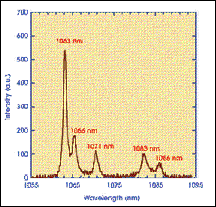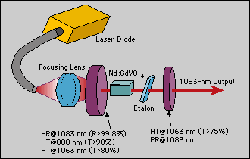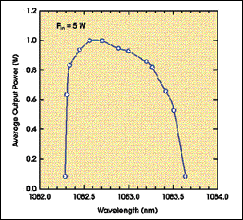
Nd:GdVO4 Laser Is Tunable Around 1.08 µm
Breck Hitz
At National Chiao Tung University in Hsinchu, Taiwan, researchers have demonstrated what they believe is the first 1.08-µm Nd:GdVO4 laser and have shown that Nd:GdVO4 is superior to other sources that have been developed for the optical pumping of helium at this wavelength. Laser sources at 1.08 µm are imperative for optically pumping helium in helium magnetometers as well as for applications in atomic cooling and trapping and in fundamental atomic and nuclear studies.

Figure 1. The fluorescence spectrum of the 4F3/2 → 4I11/2 transition in Nd:GdVO4 shows the standard 1.06-µm transition as well as weaker transitions at 1.083 and 1.086 µm.
GdVO4 is a good host for neodymium because of its high pump absorption and high thermal conductivity, but the neodymium line at 1.06 µm is several times stronger than that at 1.08 µm (Figure 1). The trick to generating 1.08-µm output from an Nd:GdVO4 laser is to suppress resonator feedback at 1.06 µm. The researchers accomplished this by selecting mirrors from Elksa Co. of Vilnius, Lithuania, whose reflectivity at 1.06 µm was low (Figure 2). The laser's gain medium was a 10-mm-long crystal of 0.27-atomic-percent-doped Nd:GdVO4, pumped with up to 16 W of 808-nm light from a fiber-coupled diode laser. The pump beam's radius in the laser crystal was approximately 250 µm.

Figure 2. The strong transition at 1.06 µm did not lase because the resonator mirrors provided inadequate feedback at that wavelength. Instead, lasing occurred at 1.08 µm, where the mirror reflectivities were much higher.
When the researchers placed a 2.7-percent-transmitting output coupler on the laser, they generated 3.4 W of 1.083-µm power with a spectral width of ~0.4 nm. The optical pump power was 12.5 W for this result, and the laser's slope efficiency was 30 percent. They obtained a slightly lower result -- 2.7 W at 1.083 µm and a 24 percent slope efficiency -- with a 2.2 percent output coupler, although the threshold was somewhat lower.
The beam quality measurements yielded an M2 value of less than 1.5 with both output couplers and at all pump powers. Comparing the slope efficiencies of the laser at 1.06 and 1.08 µm, the researchers concluded that the quantum efficiency at 1.08 µm is approximately half that at 1.06 µm.

Figure 3. By tilting the intracavity etalon, the researchers were able to tune the laser from 1.0823 to 1.0836 µm.
The laser's bandwidth shrank from ~0.4 to ~0.05 nm when the researchers inserted a 0.25-mm-thick uncoated etalon into the resonator, and the maximum output power dropped to 2.5 W. With angular adjustments of the etalon's orientation, they tuned the laser output from 1.0823 to 1.0836 µm, a range that covers several significant helium-pumping transitions.
The researchers also obtained dual-wavelength oscillation at both the 1.083- and 1.086-µm transitions. Because the 1.083-µm line is slightly stronger, they selected mirror reflectivities to provide slightly better feedback at 1.086 µm. As they increased pump power, they observed that the 1.086-µm line reached threshold first, and that the laser's output power increased linearly with pump power until the 1.083-µm line reached threshold.
But the two lines tend to compete for the same population inversion, and as the output at 1.083 µm increased with increasing pump power, the output at 1.086 diminished as its gain was usurped. Nevertheless, at about 8 W of pump power, the laser simultaneously produced about 1.5 W at each wavelength.
Published: September 2005